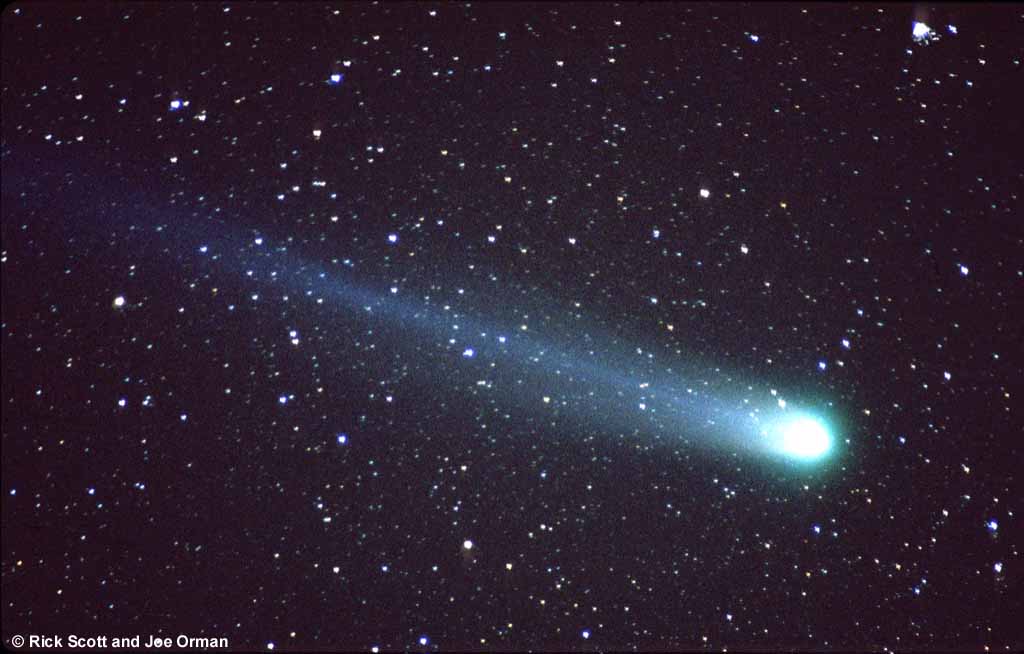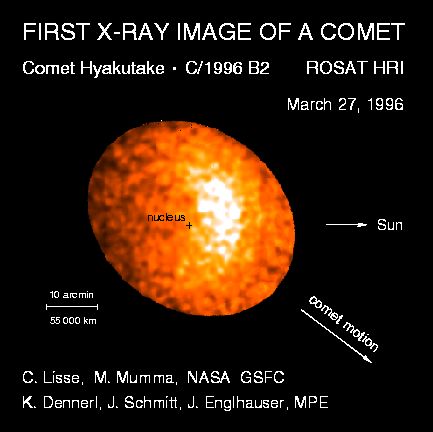Hyakutake: Comet with a Long, Long Tail
Comet Hyakutake was a naked-eye comet that made its closest approach to Earth in March 1996 after being discovered just two months earlier.
First spotted through binoculars, the comet remained visible to the naked eye for three months and was the brightest comet seen in 20 years. Its tail was perhaps its most spectacular feature, stretching out more than 100 degrees as seen from Earth, according to NASA.
Completely coincidentally, Hyakutake's appearance happened just a year before Comet Hale-Bopp – then known to be approaching Earth – made a spectacular appearance in skies in 1997. Thousands of images of the comets were posted on the Internet, then a young but popular phenomenon.
A close approach by Earth
Yuji Hyakutake first spotted the comet in January 1996 using 25x150 binoculars. The amateur comet-hunter had quit his newspaper job in 1994 specifically to move to an area with less light pollution and dedicate more time to searching the skies.
According to Sky and Telescope magazine, he spent four nights a month scanning the stars from about 2 a.m. to 5 a.m. His first comet discovery came on Christmas Day 1995, when he spotted what was later designated C/1995 Y1. The more famous discovery came just five weeks later.
"I'm a bit perplexed by all the attention paid to me, when it is the comet that deserves the credit," said Hyakutake in statement published in Sky and Telescope after his death in 2002 at age 51, from an aneurysm.
Breaking space news, the latest updates on rocket launches, skywatching events and more!
The new visitor, officially dubbed Comet C/1996 B2, was about 2 astronomical units or Earth-sun distances away at the time of its discovery. It would skim very close to Earth at about a tenth of an AU, or 9.3 million miles (15 million kilometers) away, at its closest approach.
In statistics released by Harvard University at the time, the university said that was the closest of any comet since 1983 and the fifth-closest in a century. By some reports, Hyakutake was so close that you could see it move among the background stars in a single night.
However, a statement from Harvard pointed to Hyakutake's appearance as possibly being underwhelming in urban environments.
"The increase in light pollution made comet C/1996 B2 (Hyakutake) harder to see for many people, regardless of its brightness. This, combined with a high standard for 'spectacular' activities, could detract from public perception of this comet," the statement read.
Tales of the tail
The find still excited amateur astronomers, however. The Southern Hemisphere got a look at the comet as it made its faint approach to Earth. Then, it arrived in the Northern Hemisphere just as it began to get close and interesting.
By mid-March, the first signs of a tail were visible by amateurs. In the coming days, to everyone's delight, the tail kept growing and glowed in green as it got larger. As it reached its closest approach to Earth, the tail began to extend far across the sky.
"Once the moon had set [on March 24], the tail was visible for at least 25 degrees with direct vision and well over 40 degrees with averted vision," noted a British Astronomical Association account from some of its observers.
"On that night, the comet totally dominated the sky and many of the best photographers were taken."
Hyakutake's visibility from orbit was even more spectacular, according to the astronauts aboard mission STS-76 on space shuttle Atlantis.
"Atlantis' astronauts viewed Comet Hyakutake early this morning as it continued its close pass by Earth, and they told reporters the comet was brilliant and could be seen almost from horizon to horizon," NASA said in a press statement on March 26, 1996.
'We have our work cut out for us'
NASA and observatories around the world, naturally, collected as much information about the comet as they could during its time near Earth. Astronomers made several discoveries during the months that Hyakutake was visible.
On March 27, U.S. and German astrophysicists announced they had seen the first X-rays emitted from a comet.
"We had no clear expectation that comets shine in X-rays, but the opportunity to search for this radiation in a comet coming so close to the earth was too good to miss," stated Michael J. Mumma of NASA's Goddard Space Flight Center.
"Now we have our work cut out for us in explaining these data, but that's the kind of problem you love to have."
Two days later, a radar antenna at the NASA Goldstone Deep Space Communication Complex measured the size of the comet's nucleus, at an estimated less than two miles across.
The tail's size continued to surprise scientists after the comet made its closest approach to Earth. In May 1996, an instrument on the sun-pointing Ulysses spacecraft "suddenly went haywire" for several hours, according to an account in Physics World.
It turned out that the instrument, which was supposed to measure particles in the solar wind, actually had stumbled across Hyakutake's tail at a distance of 311 million miles (500 million kilometers) from the comet's nucleus.
"The length of the comet's tail was therefore twice that of the previous record holder - the 'Great March Comet' of 1843," Physics World wrote, and the find was surprising to a lot of astronomers.
"The odds that Ulysses' flight path would intersect the comet tail were probably less likely than someone breaking the bank at Monte Carlo," stated Edward Smith of NASA's Jet Propulsion Laboratory, who was the Ulysses project scientist in 2000, when the find was announced.
It will be a long, long time before Hyakutake makes the journey near Earth again; one NASA prediction from 1996 said it would be 14,000 years before the comet arrives again, but accounts vary due to the uncertainty of predicting the comet's trajectory.
Comet-watchers in 2013, however, have a potentially bright comet to look forward to. Comet ISON could be as bright as the full moon if it performs as advertised.
— Elizabeth Howell, SPACE.com Contributor
Related:

Elizabeth Howell (she/her), Ph.D., was a staff writer in the spaceflight channel between 2022 and 2024 specializing in Canadian space news. She was contributing writer for Space.com for 10 years from 2012 to 2024. Elizabeth's reporting includes multiple exclusives with the White House, leading world coverage about a lost-and-found space tomato on the International Space Station, witnessing five human spaceflight launches on two continents, flying parabolic, working inside a spacesuit, and participating in a simulated Mars mission. Her latest book, "Why Am I Taller?" (ECW Press, 2022) is co-written with astronaut Dave Williams.



